Related Research Articles

Nam June Paik was a Korean American artist. He worked with a variety of media and is considered to be the founder of video art. He is credited with the first use (1974) of the term "electronic super highway" to describe the future of telecommunications.

Gimhae International Airport is located on the western end of Busan, South Korea. The name "Gimhae" comes from the nearby city of Gimhae. It opened in 1976. A new international terminal opened on October 31, 2007. Gimhae International Airport is the main hub for Air Busan, and a secondary hub for Asiana Airlines and Korean Air. Runway 18L/36R is used for military purposes only for Gimhae Air Base, but due to increasing traffic, there are plans to open the runway for airliners. In 2018, 17,064,613 passengers used the airport.
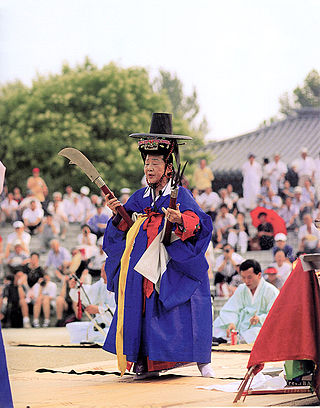
Korean shamanism or Mu-ism is a religion from Korea. In the Korean language, alternative terms for the tradition are musok and mugyo. Scholars of religion have classified it as a folk religion. There is no central authority in control of the religion and much diversity exists among practitioners.

Korean mythology is the group of myths told by historical and modern Koreans. There are two types: the written, literary mythology in traditional histories, mostly about the founding monarchs of various historical kingdoms, and the much larger and more diverse oral mythology, mostly narratives sung by shamans or priestesses (mansin) in rituals invoking the gods and which are still considered sacred today.
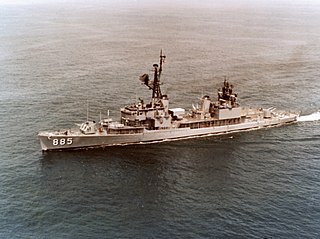
USS John R. Craig (DD-885) was a Gearing-class destroyer in service with the United States Navy from 1945 to 1979. She was sunk as a target in June 1980.
Barbara Gluck is an American photojournalist, art photographer, speaker, writer, and healing facilitator.

The National Museum of Contemporary Art, Korea (MMCA) is a contemporary art museum with four branches in Gwacheon, Deoksugung, Seoul and Cheongju. The museum was first established in 1969 as the only national art museum in the country accommodating modern and contemporary art of Korea and international art of different time periods.

Mu (무) is an ancient Korean word defining a shaman in the Korean traditional religion. Korean shamans hold rituals called gut for the welfare of the individuals and the society.
Jane Jin Kaisen is a visual artist and filmmaker based in Copenhagen, Denmark.
Gallery Hyundai was founded in 1970, initially located in Insadong, South Korea. The founder and president of the gallery, Park Myung-ja introduced modern and contemporary art to the Korean public. Many exhibitions were held throughout the past four decades, including paintings by Philippe Pasqua, Lee Ufan, Kim Tschangyeul, Kim Whanki, Lee Joongseob, Chung Sanghwa and Park Su-geun. Also video artist, Paik Nam June held multiple solo exhibitions at Gallery Hyundai, and in 1990, Paik performed a shamanic ritual called A pas de Loup de Séoul à Budapest in the back courtyard of Gallery Hyundai to commemorate Joseph Beuys' death. Starting from 1987, Gallery Hyundai started to participate in international art fairs such as Art Chicago, FIAC, Art Basel, Frieze Masters London (2014) and Frieze New York(2012–2015). Gallery Hyundai moved its location to Sagan-dong (Samcheong-ro) in 1975. 2015 marks Gallery Hyundai's 45th anniversary since its opening.

Viet Thanh Nguyen is a Vietnamese-American professor and novelist. He is the Aerol Arnold Chair of English and Professor of English and American Studies and Ethnicity at the University of Southern California.
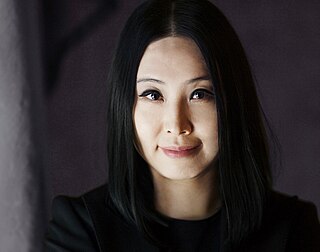
KyungHwa Lee (Korean: 이경화) is a visual art/new media artist/ director/ writer exploring the experimental nature of contemporary art from the perspectives of architecture, fashion, and philosophy. She serves as the International Director of the Nam June Paik Cultural Foundation and is a columnist for The Korea Times.
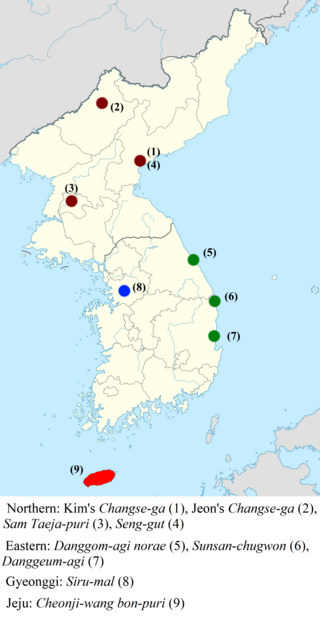
Korean creation narratives are Korean shamanic narratives which recount the mythological beginnings of the universe. They are grouped into two categories: the eight narratives of mainland Korea, which were transcribed by scholars between the 1920s and 1980s, and the Cheonji-wang bon-puri narrative of southern Jeju Island, which exists in multiple versions and continues to be sung in its ritual context today. The mainland narratives themselves are subdivided into four northern and three eastern varieties, along with one from west-central Korea.
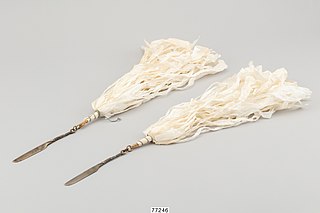
The mengdu, also called the three mengdu and the three mengdu of the sun and moon, are a set of three kinds of brass ritual devices—a pair of knives, a bell, and divination implements—which are the symbols of shamanic priesthood in the Korean shamanism of southern Jeju Island. Although similar ritual devices are found in mainland Korea, the religious reverence accorded to the mengdu is unique to Jeju.

Gongsim is a legendary Korean princess of the Goryeo dynasty said to have been struck with sinbyeong, an illness which can only be cured by initiation into shamanism. According to the myth, she joined the shamanic priesthood at Namsan Mountain in Seoul, and introduced the shamanic religion to Korea or to parts of Korea.

The Durin-gut, also called the Michin-gut and the Chuneun-gut, is the healing ceremony for mental illnesses in the Korean shamanism of southern Jeju Island. While commonly held as late as the 1980s, it has now become very rare due to the introduction of modern psychiatry.
In Korean shamanism, the Chogong bon-puri is a shamanic narrative whose recitation forms the tenth ritual of the Great Gut, the most sacred sequence of rituals in Jeju shamanism. The Chogong bon-puri is the origin myth of Jeju shamanic religion as a whole, to the point that shamans honor the myth as the "root of the gods" and respond that "it was done that way in the Chogong bon-puri" when asked about the origin of a certain ritual. It also explains the origin of the mengdu, the sacred metal objects that are the source of a Jeju shaman's authority. As with most works of oral literature, multiple versions of the narrative exist. The summary given below is based on the version recited by the high-ranking shaman An Sa-in (1912–1990).
Rape during the Vietnam War, as well as other acts of wartime sexual violence, was committed against Vietnamese civilians by military personnel from the United States, South Korea, and other combatants. According to American academic Elisabeth Jean Wood, wartime rape was frequently committed by U.S. troops because their commanders tolerated them. Weaver stated that not only were documented crimes against Vietnamese women by United States military personnel ignored during the international legal discourse which occurred immediately after the war, modern feminists and other anti-war rape campaigners, as well as historians, have continued to dismiss them.
'Yeesookyung is a South Korean multi-disciplinary artist and sculptor best known for her Translated Vase series which utilizes the broken fragments of priceless Korean ceramics to form a new sculpture. Yee's biomorphic sculptures highlight the beauty and possibility after rupture. Her other works in installation and drawings explore psycho-spiritual introspection, cultural deconstruction, kitsch, as well as Korean traditional arts and history melded with contemporary aesthetics.
References
- ↑ writer profile
- ↑ "Brenda Paik Sunoo: ThingsAsian". Archived from the original on 2010-02-06. Retrieved 2010-06-11.
- ↑ amazon book: Seaweed and Shamans
- ↑ amazon book: Vietnam Moment
- ↑ book review: Vietnam Moment